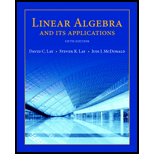
Concept explainers
Exercises 25–29 show how the axioms for a
26. Complete the following proof that −u is the unique vector in V such that u + (−u) = 0. Suppose that w satisfies u + w = 0. Adding −u to both sides, we have
Want to see the full answer?
Check out a sample textbook solution
Chapter 4 Solutions
Linear Algebra and Its Applications (5th Edition)
Additional Math Textbook Solutions
Elementary & Intermediate Algebra
Introductory Statistics
A Problem Solving Approach To Mathematics For Elementary School Teachers (13th Edition)
Math in Our World
Basic College Mathematics
Finite Mathematics for Business, Economics, Life Sciences and Social Sciences
- Solve themarrow_forwardI want to learn this topic l dont know anything about itarrow_forwardSolve the linear system of equations attached using Gaussian elimination (not Gauss-Jordan) and back subsitution. Remember that: A matrix is in row echelon form if Any row that consists only of zeros is at the bottom of the matrix. The first non-zero entry in each other row is 1. This entry is called aleading 1. The leading 1 of each row, after the first row, lies to the right of the leading 1 of the previous row.arrow_forward
- PRIMERA EVALUACIÓN SUMATIVA 10. Determina la medida de los ángulos in- teriores coloreados en cada poligono. ⚫ Octágono regular A 11. Calcula es número de lados qu poligono regular, si la medida quiera de sus ángulos internos • a=156° A= (-2x+80 2 156 180- 360 0 = 24-360 360=24° • a = 162° 1620-180-360 6=18-360 360=19 2=360= 18 12. Calcula las medida ternos del cuadrilá B X+5 x+10 A X+X+ Sx+6 5x=3 x=30 0 лаб • Cuadrilátero 120° 110° • α = 166° 40' 200=180-360 0 = 26-360 360=20 ひ=360 20 18 J 60° ⚫a=169° 42' 51.43" 169.4143180-340 0 = 10.29 54-360 360 10.2857 2=360 10.2857 @Saarrow_forwardPlease help I'm a working mom trying to help my son last minute (6th grader)! Need help with the blank ones and check the ones he got with full calculation so we can use it to study! Especially the mixed number fractions cause I'm rusty. Thanks in advance!arrow_forward|| 38 5층-11- 6 4 7 2 6arrow_forward
- Ms.sally has 12 studentsMr Franklin has twice as many students as Ms. Sally.how many students does Mr Franklin have?arrow_forwardexplainwhat is means for a shape to be symmetricarrow_forwarde Grade Breakdown x Dashboard | Big Spring HX Dashboard | Big Spring H x Home | Lesson | Assessm cds.caolacourses.edisonlearning.com/lessons/assessmentplayer Co bigspringsd.org bookmarks Prodigy New Tab my video Brielynn... Algebra 2 Part 1-Exam-EDCP.MA003.A D Question 6 D ? 10 17°F Mostly sunny BSMS Home Significant Events in... Classes 25 26 27 28 29 30 31 32 33 34 35 36 37 38 39 40 Solve using row operations: x-3y= -4; 2x - y = 7 Use the paperclip button below to attach files. Student can enter max 2000 characters BISU DAIAAA X2 X2 T ② Type here Q Search e I ✓ Paragra Oarrow_forward
 Elementary Linear Algebra (MindTap Course List)AlgebraISBN:9781305658004Author:Ron LarsonPublisher:Cengage LearningAlgebra & Trigonometry with Analytic GeometryAlgebraISBN:9781133382119Author:SwokowskiPublisher:Cengage
Elementary Linear Algebra (MindTap Course List)AlgebraISBN:9781305658004Author:Ron LarsonPublisher:Cengage LearningAlgebra & Trigonometry with Analytic GeometryAlgebraISBN:9781133382119Author:SwokowskiPublisher:Cengage Linear Algebra: A Modern IntroductionAlgebraISBN:9781285463247Author:David PoolePublisher:Cengage Learning
Linear Algebra: A Modern IntroductionAlgebraISBN:9781285463247Author:David PoolePublisher:Cengage Learning


